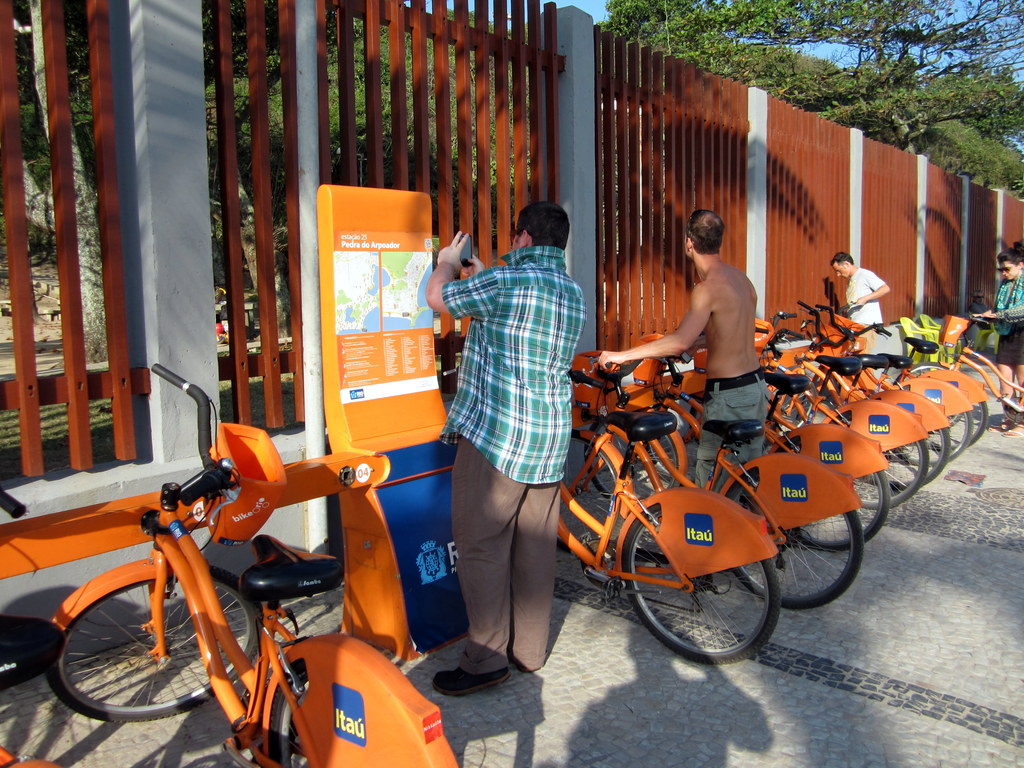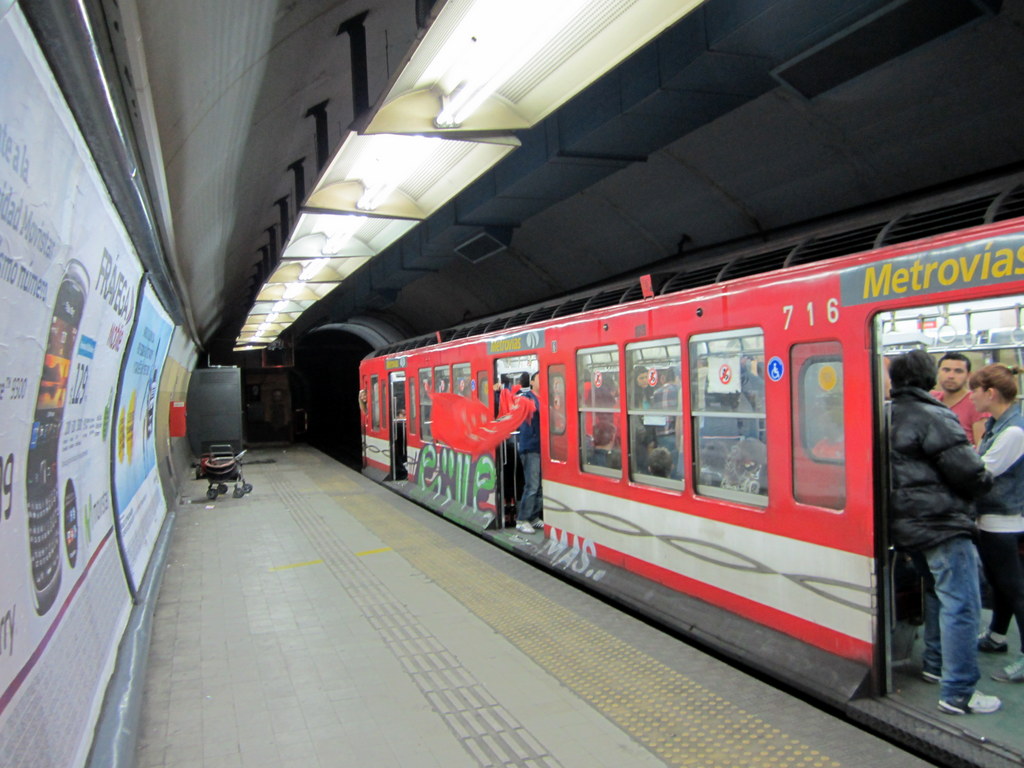Active Transportation in South America
- Sept. 28, 2012
 Transportation Research in Rio!
South America has seen a number of innovative, and at times daring, active transportation initiatives that reflect a new vision about what they want their cities to be like. Gone are the days where cars were seen as the sole future of transportation, an ideal best embodied by the completely master planned Brasilia. What we see today are cities all over the continent working to create places where people have more transportation choices and where cycling and walking can take root again. There seems to be a change in attitude towards cars and their role in society, including the quote from an ex-Mayor of Bogotá: "An advanced city is not a place where the poor move about in cars, rather it’s where even the rich use public transportation."*
Based on what has been happening on the ground, it's clear that this new vision of what an advanced city looks like also includes biking and walking as a sign of prosperity. The City of Bogotá has not only been aggressively building cycletracks but was among the first to introduce a regular car-free day for the city streets. Ciclovía happens every Sunday and on Holidays between 8am and 2pm and sees much of the city streets open to pedestrians and cyclists. The idea has been adopted in a number of different places including Los Angeles (CycLAvia) and Rio de Janeiro as I found out while I was there. I visited Buenos Aires and Rio de Janeiro to see first hand what they have been doing on this front and both cities have been investing in car-free transportation options.
Transportation Research in Rio!
South America has seen a number of innovative, and at times daring, active transportation initiatives that reflect a new vision about what they want their cities to be like. Gone are the days where cars were seen as the sole future of transportation, an ideal best embodied by the completely master planned Brasilia. What we see today are cities all over the continent working to create places where people have more transportation choices and where cycling and walking can take root again. There seems to be a change in attitude towards cars and their role in society, including the quote from an ex-Mayor of Bogotá: "An advanced city is not a place where the poor move about in cars, rather it’s where even the rich use public transportation."*
Based on what has been happening on the ground, it's clear that this new vision of what an advanced city looks like also includes biking and walking as a sign of prosperity. The City of Bogotá has not only been aggressively building cycletracks but was among the first to introduce a regular car-free day for the city streets. Ciclovía happens every Sunday and on Holidays between 8am and 2pm and sees much of the city streets open to pedestrians and cyclists. The idea has been adopted in a number of different places including Los Angeles (CycLAvia) and Rio de Janeiro as I found out while I was there. I visited Buenos Aires and Rio de Janeiro to see first hand what they have been doing on this front and both cities have been investing in car-free transportation options.
 This could be an advertisement, but it is actually just two people enjoying Ipanema.
In Rio de Janeiro, I found a well established and inexpensive bike share system set up in the central part of the city as well as car-free Sundays by the beaches in the most popular destinations. The beaches have right beside them freeways -in effect- that are six lanes wide and create a barrier between the city itself and the beach. On Sundays, three of these lanes closest to the beach are closed to traffic and open to beachgoers of all types. People on skateboards, bikes, and families with jump ropes take over the space during this time and the extra space helps people (and the beach based merchants) move up and down the long beach freely. Outside of the area, traffic is effectively unchanged.
This could be an advertisement, but it is actually just two people enjoying Ipanema.
In Rio de Janeiro, I found a well established and inexpensive bike share system set up in the central part of the city as well as car-free Sundays by the beaches in the most popular destinations. The beaches have right beside them freeways -in effect- that are six lanes wide and create a barrier between the city itself and the beach. On Sundays, three of these lanes closest to the beach are closed to traffic and open to beachgoers of all types. People on skateboards, bikes, and families with jump ropes take over the space during this time and the extra space helps people (and the beach based merchants) move up and down the long beach freely. Outside of the area, traffic is effectively unchanged.
 Car free Sundays along Ipanema beach. All day, no cars, just people.
Car free Sundays along Ipanema beach. All day, no cars, just people.
Rio de Janeiro also has a well established bike share system that opened up in 2010. The system has a variety of stations throughout town and the cost is about $5 a month to ride as much as you want. The system allows for one-way rentals, meaning that you can rent a bike on Ipanema and return it at a different station in Leblon or Copcabana without any extra charges. Renters use their cellphones to call a number (no smart phone required) and unlock the bike by punching in the station number and bike number on their keypad. It's a simple system and everywhere you look, you see the bright orange bikes with their Itau sponsorship stickers. Biking in Rio still isn't a utopia, but there are more bike paths and cycletracks popping up throughout the city, especially in the nicer tourist areas.
 Bike Sharing Station in Rio de Janeiro
Buenos Aires has also been amazingly proactive in reintroducing Porteños to cycling in their city. In 2009, the city had virtually nothing for bikes: Sidewalks are not wide enough to mix pedestrians and cyclists, and traffic has... its own rules. Since then, 49 miles of protected cycletracks have been built and the city is currently offering residents free bikes to use an hour at a time in the central city. You simply walk up to one of the stations, talk with the attendant, and away you go. In addition, the city is currently in the middle of a major campaign to promote cycling and a greener Buenos Aires.
Bike Sharing Station in Rio de Janeiro
Buenos Aires has also been amazingly proactive in reintroducing Porteños to cycling in their city. In 2009, the city had virtually nothing for bikes: Sidewalks are not wide enough to mix pedestrians and cyclists, and traffic has... its own rules. Since then, 49 miles of protected cycletracks have been built and the city is currently offering residents free bikes to use an hour at a time in the central city. You simply walk up to one of the stations, talk with the attendant, and away you go. In addition, the city is currently in the middle of a major campaign to promote cycling and a greener Buenos Aires.
 Bike Sharing Station in Buenos Aires: One hour free for residents.
Bike Sharing Station in Buenos Aires: One hour free for residents.
 Cycletrack and bike sharing in action. These streets form a grid in the central city.
The other thing that is happening in Buenos Aires is that they are actively expanding their subway (known as the "Subte"). The subway system currently has about 30 miles of rail serving the city, but future plans call for double that: 62 miles in total will serve the city. The new tracks will be a combination of completely new tunnels and subway lines and extensions to the current system. The new lines will add much-needed north/south connections and allow people to travel to more places without having to come downtown.** Ground was broken on the new H line earlier this year.
Cycletrack and bike sharing in action. These streets form a grid in the central city.
The other thing that is happening in Buenos Aires is that they are actively expanding their subway (known as the "Subte"). The subway system currently has about 30 miles of rail serving the city, but future plans call for double that: 62 miles in total will serve the city. The new tracks will be a combination of completely new tunnels and subway lines and extensions to the current system. The new lines will add much-needed north/south connections and allow people to travel to more places without having to come downtown.** Ground was broken on the new H line earlier this year.
 The "Subte" complete with football fans. These are the older cars, but new cars are being put in service and arrived earlier this year.
As exciting as things are in South America, here in Seattle we have our own challenges and our own questions to ask about what we want our cities to be like. When we look at our city now, do we see the "advanced city" that we want or something different? Bogotá, Rio de Janeiro, and Buenos Aires have been working to see their vision of a city where biking and walking is possible again. What do we want our Seattle to be like?
The "Subte" complete with football fans. These are the older cars, but new cars are being put in service and arrived earlier this year.
As exciting as things are in South America, here in Seattle we have our own challenges and our own questions to ask about what we want our cities to be like. When we look at our city now, do we see the "advanced city" that we want or something different? Bogotá, Rio de Janeiro, and Buenos Aires have been working to see their vision of a city where biking and walking is possible again. What do we want our Seattle to be like?
 *This quote went viral a week ago when it was attributed to the current Mayor of Bogotá with a slight variation, "A developed country is not a place where the poor have cars. It's where the rich use public transportation."
**Much like other places where downtown was seen as the only destination to matter, travel between the branches of the metro can be troublesome. Stockholm is another example of a city where the subway lines radiate out from the center and were getting between the branches without going to the center can be troublesome.
*This quote went viral a week ago when it was attributed to the current Mayor of Bogotá with a slight variation, "A developed country is not a place where the poor have cars. It's where the rich use public transportation."
**Much like other places where downtown was seen as the only destination to matter, travel between the branches of the metro can be troublesome. Stockholm is another example of a city where the subway lines radiate out from the center and were getting between the branches without going to the center can be troublesome.